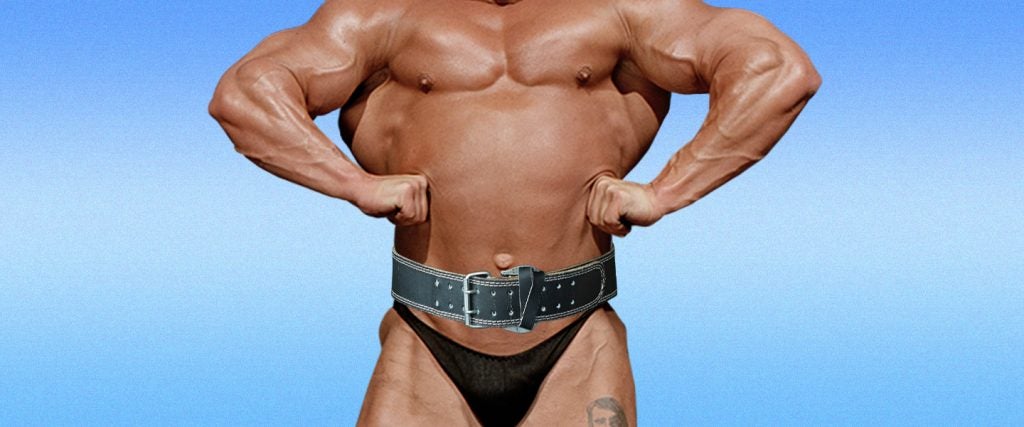I get accused by a lot of my friends of wearing Adidas pants a full 90 percent of the time. Not only is that a true statement, but it might actually be a low estimate; I’m usually dressed as if a full-blown HIIT workout might break loose at any moment, and I don’t want to be stuck doing kettlebell swings in jeans.
But if I look like I’m always prepared to train simply because I’m wearing warm-up pants, then Hulk Hogan really looked like he was prepared to train every time he did an interview with “Mean” Gene Okerlund, and even during some of his matches as the villainous leader of the New World Order. The reason? Hogan was seen with a weightlifting belt fastened around his waist everywhere he went, I guess just in case a squatting or deadlifting opportunity presented itself while he was grocery shopping for eggs to drop into his blender.
How does a weightlifting belt even work? I don’t get how a strip of leather makes that much of a difference to my lifting quality.
I agree that a weightlifting belt doesn’t necessarily pass the eyeball test, which is why it’s often helpful to rely on some cold, hard scientific evidence.
During a 1990 study conducted back when experts were trying to get to the root of what was going on behind the performance boost administered by weightlifting belts, researchers compared what was occurring within the bodies of people executing squats while wearing or not wearing weightlifting belts, along with where the pressure of the weight was being distributed throughout their bodies. The three conditions under which people were requested to lift involved wearing a heavy belt, wearing a light belt and wearing no belt whatsoever. The pressure placed on the body was measured through an analog-to-digital converter that captured ground reaction force and intra-abdominal pressure, along with EMG recordings for the rectus abdominis, external obliques and erector spinae muscles.
The results showed that the mean intra-abdominal pressure was greatest when squats were performed when a heavy weightlifting belt was worn, and lowest when no belt was worn. Conversely, the results for the erector spinae followed an inverted pattern, where pressure on the erector spinae was at its peak when no belt was worn, and at its lowest when the heavy weightlifting belt was worn. Peak EMG values for the heaviest one-rep-maximum lifts reached 22.3 percent for the no-belt lift and 18.1 percent for the heavy-belt lift.
This 4.2 percentage-point dip may not seem like much, but when readjusted to capture the relative reduction in force, those 4.2 percentage points represent a near 20-percent alleviation of pressure from the erector spinae, and a redistribution of the bulk of that pressure to the abdominal region.
Only 20 percent? That doesn’t sound like a whole lot!
Well, let’s assume that ratio holds constant no matter how many plates you place on a weight bar, and then let’s further assume that most workout-to-workout gains are made in small increments as opposed to massive surges. With this being the case, a 20-percent increase in weight would be the leap from 200 pounds to 240 pounds. If the weight belt is able to transfer a significant portion of the lifted weight away from the erector spinae and over to the sets of muscles that are less likely to give out during the course of a lift, it makes it easier to endure the added weight without directly increasing the amount of weight supported by the back.
To put it another way, if the goal of squatting is primarily to increase the strength of the legs, wearing a weightlifting belt reduces the likelihood that a weakness in the back would be a limiting factor that would prevent the legs from adding to their strength.
Are you actually suggesting that I should wear one of those stupid things?
Not only am I suggesting it, but I’d downright insist upon you never performing any heavy squatting, deadlifting, power cleaning or any other heavy load-bearing exercises without one.
The three most costly mistakes of my weightlifting life — and we’re talking about hundreds of mistakes — have all involved instances when I was either attempting to lift much heavier quantities of weight than I should have been attempting to lift without a weight belt, or lifting heavier quantities of weight than I should have been lifting without permitting myself to fully recover from a prior back injury.
All of those injuries were suffered while performing squats or deadlifts, and it’s possible that I never would have sustained any of them — and that I’d still be executing regular squats and deadlifts to this day — had it not been for the absence of a weight belt around my waist during those critical moments.
So you might think you look silly, but you’ll never look sillier than when you’re practically crawling out to the gym’s swimming pool on your hands and knees after you stopped at the front desk to tell them that you’re too injured to re-rack the weight plates on the barbell you left in the middle of the weight room.
Trust me; I’ve been there.

